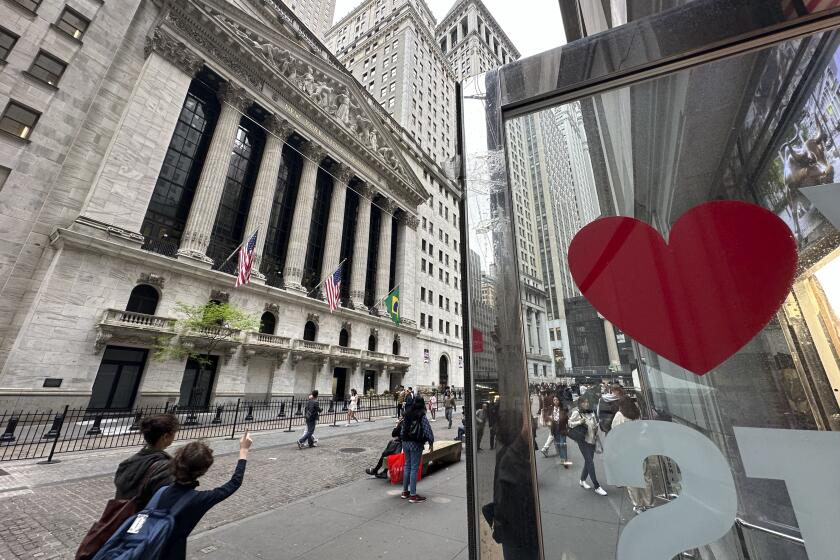Long-Term Bond Yields Drop Below 7% : Buying Raises Comparisons With ’93 Binge That Set Up Crash Last Year
Interest rates plunged with renewed vengeance Tuesday, as fresh signs of economic weakness sent the yield on long-term government bonds below 7% for the first time in a year.
But the steamroller that the bond market rally has become over the past week, while fueled in part by the seeming certainty of a slowing economy, is also raising worrisome comparisons with the 1993 speculative buying binge that set up last year’s horrendous bond market crash.
In other words, some analysts fear that the bond market is again being driven principally by “hot money” players who are motivated less by economic fundamentals than by sheer momentum: the chance to ride yields down (and thus bond prices up) for as long as possible.
When those players hopped off the 1993 bond steamroller, the market quickly went into reverse in ‘94, mowing down an army of investors who had trailed happily along.
“If you’re just looking at the economy’s fundamentals, the bond market is way ahead of itself” with this year’s rally, contends William Griggs at financial consulting firm Griggs & Santow in New York.
But that argument has been put forth by other bond market doubters since January, to little effect. Yields have continued to slide, gradually at first, then in a virtual free fall beginning May 2.
On Tuesday, the bellwether 30-year Treasury bond yield tumbled to 6.94%, down from 7.03% on Monday and 7.34% on May 1. Tuesday’s yield is the lowest since March, 1994--the month after the Federal Reserve Board began pushing up interest rates to slow the economy.
Intermediate-term yields have also been plummeting over the past week as buyers have snapped up bonds across the board. The yield on two-year T-notes, 7.60% at the end of 1994 and 6.60% on May 1, has collapsed to 6.09% now.
And yields on three- and six-month T-bills have fallen to 5.80% and 5.91%, respectively--actually below the 6% rate that the Fed still maintains as the benchmark shortest-term interest rate, the overnight federal funds rate.
How is it that T-bill buyers are happy to lock in a six-month yield that is below the “official” overnight interest rate? That’s one of the bizarre aspects of the 1995 bond market rally.
Most economists will concede that government statistics have overwhelmingly confirmed that the economy has slowed this year. But the bond market has increasingly appeared to look upon the slowdown as so pronounced that it will lead the Fed to soon reverse its policy of tighter credit and begin cutting interest rates again.
Yet Fed governors have shown no signs that they are contemplating lowering interest rates, at least not at the next Fed board meeting May 23.
“At best, we’re going to have neutral Fed policy” for some time to come, argues Ian MacKinnon, head of bond investments at the Vanguard Group of mutual funds in Valley Forge, Pa.
*
If he is correct and the Fed holds overnight interest rates at 6% well into summer, it should become extremely difficult for rational investors to justify buying a two-year T-note at just 6.09%.
There are, however, two types of bond buyers for whom a 6.09% yield on a two-year T-note might still seem appealing. One type would be the investor who fervently believes the U.S. economy is not just slowing, but is on the verge of outright recession--which should inevitably lead to a further deep decline in interest rates soon.
Is the bond market a savvy predictor of recessions? Sometimes. But it’s also true that the bond market, like the stock market, periodically anticipates economic events that never happen. When a trend gets going--like higher interest rates in 1994--investors often extrapolate and take things too far.
Why should we believe that the bond market’s current expectation of Fed rate cuts and-or recession in the near future is any more prescient than its apparent--and wrong--expectation last December that the economy would roar in 1995 and that rates would continue to soar?
If a bond buyer in this market isn’t a true believer in the recession forecast, then chances are that player can have only one other mind set: “I’ll buy bonds, because however little value there may be in them now, someone else will soon pay me more for that security regardless.”
In other words, this is the “greater fool” theory of investing. Also known as trading on momentum.
What scares many bond veterans is that it was the momentum players--hedge funds, brokerages and other short-term traders--who helped drive bond yields to 20- or 30-year lows in the fall of 1993. Using borrowed money ( a la Orange County), those speculators bought a mountain of bonds, never intending to hold them to maturity, but only for as long as the trend in interest rates was still in their favor, meaning down.
When the Fed reversed that trend in early 1994, the speculators bailed out and the bond market crumbled. Yields soared and bond values suffered their biggest one-year loss in this century.
Are those players back in force in the bond market? Many people think so. Whatever losses the momentum traders suffered last year, it evidently wasn’t enough to deter them from getting back on the bond-speculation train this year, says James Bianco, a bond analyst at Arbor Trading Group in Barrington, Ill.
“These are people who are just trading off the trend,” he says. What’s disturbing about their ability to swing the market so violently last year, and again this year, Bianco says, is that they have helped turn the once-staid government bond market into much more of a whipsaw-prone, commodity-like market, one more volatile recently than even the stock market.
Maybe the bond market’s transformation to a commodity market was inevitable, as the explosion of federal debt since 1980 and the development of instantaneous trading (thanks to technology) have attracted hordes of new opportunists to the market. In any case, the long-term implications of this shift are many, and not pleasant, Bianco says. For now, what he and others fear is that the bond market may again have begun a tightly wound spring, the fast uncoiling of which could send shock waves in many directions.
* MIXED MARKETS: Treasury bonds resumed their powerful rally but stocks closed mixed. D3
(BEGIN TEXT OF INFOBOX / INFOGRAPHIC)
Whiplash!
Bonds, once considered a low-volatility investment, have been anything but that since 1993. Total returns on two key bond indexes compared to two key stock indexes, the S&P; 500 an the Russell 2,000
Sources: Frank Russell, Lipper Analytical Merrill Lynch






